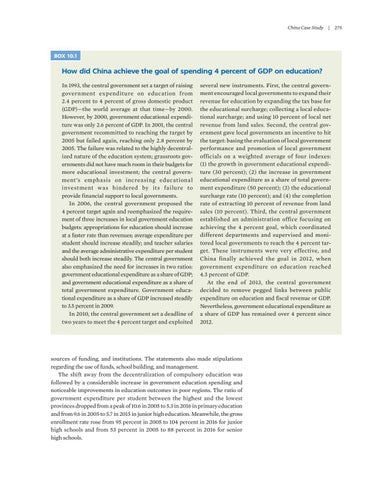China Case Study | 275
BOX 10.1
How did China achieve the goal of spending 4 percent of GDP on education? In 1993, the central government set a target of raising government expenditure on education from 2.4 percent to 4 percent of gross domestic product (GDP)—the world average at that time—by 2000. However, by 2000, government educational expenditure was only 2.6 percent of GDP. In 2001, the central government recommitted to reaching the target by 2005 but failed again, reaching only 2.8 percent by 2005. The failure was related to the highly decentralized nature of the education system; grassroots governments did not have much room in their budgets for more educational investment; the central government ’s emphasis on increasing educational i nvestment was hindered by its failure to provide financial support to local governments. In 2006, the central government proposed the 4 percent target again and reemphasized the requirement of three increases in local government education budgets: appropriations for education should increase at a faster rate than revenues; average expenditure per student should increase steadily; and teacher salaries and the average administrative expenditure per student should both increase steadily. The central government also emphasized the need for increases in two ratios: government educational expenditure as a share of GDP; and government educational expenditure as a share of total government expenditure. Government educational expenditure as a share of GDP increased steadily to 3.5 percent in 2009. In 2010, the central government set a deadline of two years to meet the 4 percent target and exploited
several new instruments. First, the central government encouraged local governments to expand their revenue for education by expanding the tax base for the educational surcharge; collecting a local educational surcharge; and using 10 percent of local net revenue from land sales. Second, the central government gave local governments an incentive to hit the target: basing the evaluation of local government performance and promotion of local government officials on a weighted average of four indexes: (1) the growth in government educational expenditure (30 percent); (2) the increase in government educational expenditure as a share of total government expenditure (50 percent); (3) the educational surcharge rate (10 percent); and (4) the completion rate of extracting 10 percent of revenue from land sales (10 percent). Third, the central government established an administration office focusing on achieving the 4 percent goal, which coordinated different departments and supervised and monitored local governments to reach the 4 percent target. These instruments were very effective, and China finally achieved the goal in 2012, when g overnment expenditure on education reached 4.3 percent of GDP. At the end of 2013, the central government decided to remove pegged links between public expenditure on education and fiscal revenue or GDP. Nevertheless, government educational expenditure as a share of GDP has remained over 4 percent since 2012.
sources of funding, and institutions. The statements also made stipulations regarding the use of funds, school building, and management. The shift away from the decentralization of compulsory education was followed by a considerable increase in government education spending and noticeable improvements in education outcomes in poor regions. The ratio of government expenditure per student between the highest and the lowest provinces dropped from a peak of 10.6 in 2005 to 5.3 in 2016 in primary education and from 9.6 in 2005 to 5.7 in 2015 in junior high education. Meanwhile, the gross enrollment rate rose from 95 percent in 2005 to 104 percent in 2016 for junior high schools and from 53 percent in 2005 to 88 percent in 2016 for senior high schools.






